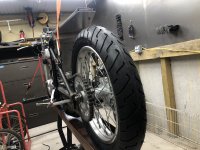Rear end is much lighter so that's good.
Zeke's times are not far from mine on the Phat Trakka. Don't encourage him to practice, because those times have room for improvement...
Your time slip is interesting. I compared that to our RZ350 and the 60' is similar but speed at the 1/8 is significantly lower and it's almost a second slower for the 1/8th and that talks to power. I only had the RZ on a dyno once and that was years ago, but it made about 56 at the rear wheel IIRC.
It's unlikely that the Bul will make that much power, but I would have expected a slightly higher speed and lower ET, so there's some more work to be done there over the winter.
I hadn't really thought through the shift timing before, but here's today's thoughts:
I use the same Pingel switch on the RD350. In theory at least, it's air pressure that activates the ram and kill switch, and whatever speed it travels at, a longer tube will always take longer for that pulse to reach the other end. For us mere mortals, that seems like it's instantaneous, but it does take time - albeit not a lot. at say 1000 ft per second in cool air, that pulse will take 1/1000 of a second to travel 1 foot and 2/1000 sec to travel 2 feet. Doesn't sound like a huge difference if the kill switch kills ignition for say 50 milliseconds which is 50/1,000 sec.
But that's the time the ignition remains off to allow the shift to complete and will all that heavy metal to move, that sounds reasonable.
The idea behind a shorter run to the ram is that you want it to start moving before the kill happens. So the air pulse travels to the ram which reacts and starts to move and take up slack in the linkages. If the ram is attached a long way from the shift shaft, it will have to travel further to make a shift and if the ram is attached closer to the shift shaft (shorter lever so less leverage but also less distance to move) it will start to move the shift mechanism earlier.
Our old fashioned shifters have a lot of movement from the shift mechanism (claws/pawls etc) to play between the shift forks and the rails and shift forks to the gears and the distance the gear have to move. And that's before the gears start to move. All that mechanical mayhem takes time, so we need to initiate the mechanical part as far ahead of the kill as possible. There's work to be done and it takes time.
So mount the solenoid as close to the ram as possible even if the gear shift has very little latency.
OR... Fit what is known as a window switch that will shift automatically at predetermined revs, then redesign the whole transmission and have the dogs cut for auto shift - basically a ramp on the engagement side of the dogs so never ever down shift or close the throttle. Then take the shift forks and measure the free play and build the ends up with hard weld and grind back to minimal side play and shim the gears and so on. But I'd just shorten the one side for now. Mount the solenoid on the shift ram if possible and see how that works.
Or fit a modern Ignitech or MSD ignition and adjust shift delay with a laptop.
BTW, my best time was set after I almost ran out of expensive race gas and tipped in some 93 octane street gas...... May be a coincidence, but who knows. I find C12 to be sluggish maybe because I need more compression to get the best out of it and U4.4, which we are not allowed to run has the best throttle response but I have not dyno tested different fuels back to back. On our Honda CB160 race bikes, they made more power with 89 octane street gas than with C12 - not by much but it was measurable (just).
So in summary, it's time for a Rotax top end with new design of transmission, thin wall frame, and titanium everything coupled to space shuttle level electronics and rocket fuel...

It all comes down to how badly you want to beat Zeke.





